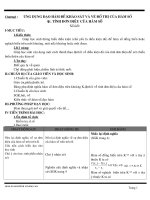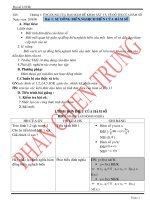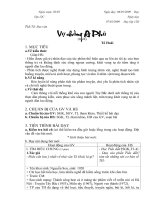giao an 12 U9 Reading
Bạn đang xem bản rút gọn của tài liệu. Xem và tải ngay bản đầy đủ của tài liệu tại đây (193.04 KB, 3 trang )
Tan Lam Upper Secondary School English 12
Date of preparation: Teaching date:
Class : 12b
2
, 12b
3
UNIT 9: DESERTS
Period: 54 Reading
I. Objectives: By the end of the lesson, the students will be able to:
Guess the meaning of words/ phrases in contexts and pictures.
Scan for specific information about Simpson Desert.
summarize the text
1. Educational aim:
To help students to read and guess the meaning of words/ phrases in contexts and pictures.
To help them scan and find information about Simpson Desert in Australia.
2. Knowledge:
Nouns : sand dunes, slope, steep, hummock grasses, crest, spinifex
3. Skill: Reading
II. Teaching aids: textbook, computer, multi-projector
III. Procedure:
Teacher’s activities Students’ activities
WARM-UP: (06 minutes)
Guessing: What is this?
- It is a very large place.
- It is very hot and dry.
- There is a lot of sand there.
PRE – READ: (14 minutes)
* Activity 1:ask and answer the questions
1. What do you know about deserts?
2. What kinds of plants and animals live in a
desert?
3. Name some of the countries, which have
deserts?
* Activity 2: presenting vocabulary
sand dunes (n) = mound of loose sand formed by
wind
slope /sloup/ (n)
- Students listen to the teacher’s guiding
and guess what it is:
Answer key: DESERTS
- Read the questions and thinks about the
topic.
1. dry, few trees, little or no water, little
rainfall, few people and animals live in a
desert…
2. cactus /’kkts/: cây xương rồng, camel
/’kml/: con lạc đà, pasture /’ps/: cỏ,
date palm: cây chà là …
3. Sahara in the north of Africa (about
9.000.000 km
2
, Simson in Australia …
cồn cát, đụn cát
dốc
Teacher: Nguyen Quang Hai
Tan Lam Upper Secondary School English 12
Steep /st
p/ (n) = sloping sharply
hummock grasses /’h
m
k/ (n)
crest (n) = top (of mountain)
spinifex /’sp
n
feks/ (n) = a kind of grass
* Activity 3: True/ False guessing
TRUE / FALSE STATEMENTS T / F
1.
There are three great deserts in Australia.
2.
In 1929, the desert was named after
Simpson.
3. The dunes are same all over the desert.
4.
There are more dunes in the Western part
of the desert.
5.
Dry salt lakes are in the northern part of
the desert.
WHILE - READ: (17 minutes)
* Task 2: True/ False statements
- Ask students to read the passage and do the true/
false statements
- Give feedback
* Task 3: (group work) asking and answering the
questions
- Asks students to work in groups and read the
passage again to answer the questions.
1. What are the names of the three great stretches
of sandy desert, which circle the centre of
Australia?
2. Where is the Simpson Desert?
3. When did the 1st European enter the desert?
4. Who was Simpson?
5. How did Colson and an Australia Aborigine
travel across the desert?
6. What are the dunes like in the western and the
northern parts of the desert?
7. How may kinds of grass grow in the Simpson
Desert? What are they?
dốc đứng
cỏ gò
đỉnh, ngọn
cỏ lá nhọn
- Students use their knowledge to guess
and decide which sentence is correct.
- Students read the passage and correct
their prediction.
TRUE/ FALSE STATEMENTS
T / F
1.
There are three great deserts in
Australia.
F
2.
In 1929, the desert was named
after Simpson.
T
3.
The dunes are same all over the
desert.
F
4.
There are more dunes in the
Western part of the desert.
F
5.
Dry salt lakes are in the northern
part of the desert.
T
- Students work in groups of 4, read and
answer the questions.
1. They are Great Victoria Desert,
Gibbon, Great Sandy and Tanami Desert,
and Great Simpson Desert
2. It lies between Lake Eyre in the south,
the Macdonnel Ranges in the north, the
Mulligan and the Diamantina Rivers in
the east, and the Macumba and Finke
Rivers in the west.
3. In 1845
4. He was the President of the South
Australian Branch of the Royal
Geographical Society of Australia.
Teacher: Nguyen Quang Hai
Tan Lam Upper Secondary School English 12
POST – READ: (7 minutes)
* Finding the location
- Ask students to remind and write down the
location of the Simpson Desert.
HOMEWORK: (3 minutes)
Read the story and answer the questions in the
After you read (page 99) and do task 1 (page 98)
5. They took camels across the desert.
6. In the western part, they are short,
mostly less than 10 meters high, and in
the northern part, they are parallel and are
up to 20 meters high.
7. Two. They are hummock grasses and
spinifex.
- Students work individually and then
compare with the others.
Teacher: Nguyen Quang Hai









